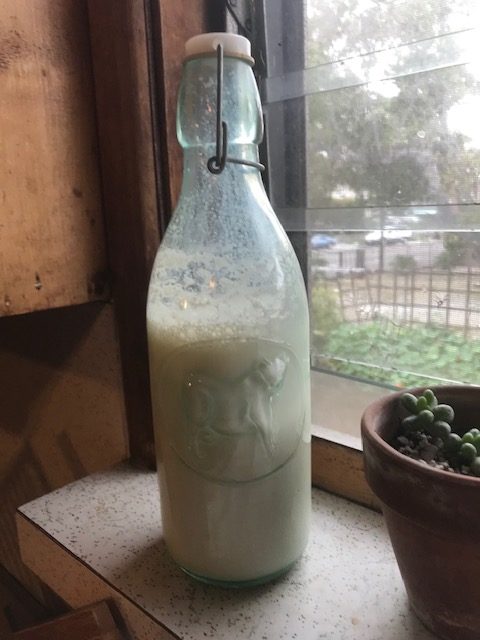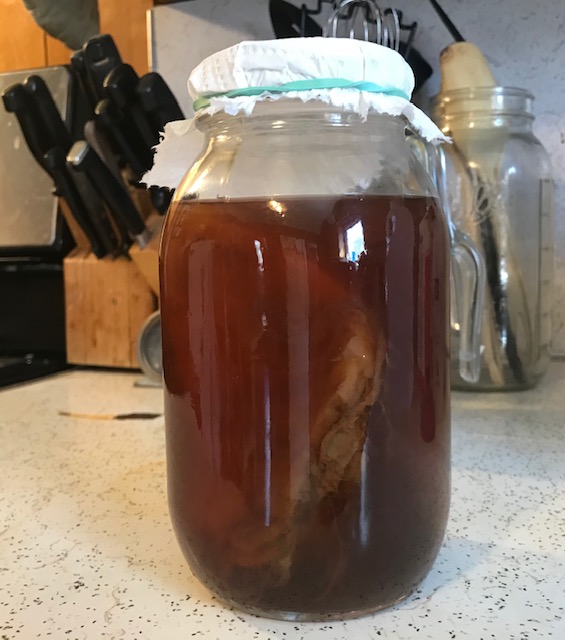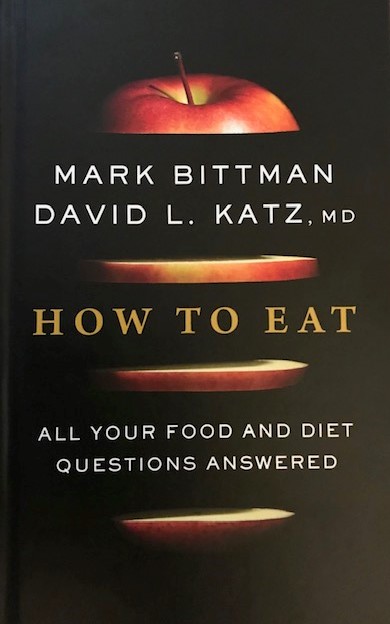My kombucha was a fail. The SCOBY wasn’t viable and it was tossed. I’ll procure another and try again.
This is my second attempt at making kefir. It’s on the shelf for its photo shoot. Do not leave your kefir in the sunlight! Heat will kill the grains.
My first attempt at kefir didn’t work out super well. I put too many kefir grains in with my milk. The ratio is important. I was a bit cocky because the hands-on part of making kefir is so.damn.easy. When you have too many grains it can grow very quickly.

I ended up with a fist sized blob of what I thought was grains within two days. The rest of the fermenting milk did not thicken into the yogurt-y texture I was anticipating. It was still like, well, milk. Turns out a lot of the mass’o’grains was curds. I continued letting the thing culture and by day 4 it the batch had split into curds and whey.
This wasn’t a tragedy. It’s basically just messy. I thought the grains were still viable. The curds and whey are edible. Curds coalesce into a sour cream consistency and can be used likewise. The whey can be used many ways including as a starter culture for other ferments.
The trick is to get the kefir grains out of the big blob. I did that by first straining it. Then it was time to get hands-on and squeeze it. The kefir grains were harder than the curds and had a texture which didn’t give when pinched between thumb and index finger. Voila! Rescued!
The proper ratio is about 1 TBSP grains to 1 quart of milk. And, you’re supposed to gently shake the mixture a few times a day to spread the grainy goodness throughout the batch. Whoops.
So I created the second batch. This time with the suggested ratio and requisite shaking. I drained the grains after 48 hours. Then I did a second ferment with a sealed lid. The internet says this might thicken it plus the anaerobic environment leads to carbonation. Cool!
This batch had the kefir-like sourness and there was carbonation so I declared the batch done, strained out the grains, bottled it with an airtight cap, and put it in the fridge. The “milk” did not thicken up. Just like the first batch.
I drank a scant .25 cup and it tasted familiar like the kefir one buys at the grocery, sans thickness. Best to introduce potentially new bacteria to your gut slowly. Sure enough, I had a mild message from my colon within 2 hours. Take that Benefiber.
I ate the kefir “cheese” on baked potatoes. Verdict? Yum. Definitely a good sour cream substitute. I imagine the heat isn’t good for the live cultures so I consider this a culinary rather than nutritional use.
I have made five additional batches as of today, all with secondary fermenting. and have gotten the same result. They all taste like kefir. I’m calling it a mild success. My theory is the grains are sluggish. I’ve heard that they might strengthen up again after several batches, so I’ll keep making batches as long as I have access to milk. I am under isolation with the rest of the world as of this writing so I am not going out for groceries unless strictly necessary.
I’ll also try a different brand of milk. It’s also heard that some pasteurized milk is ultra-pasteurized and the grains don’t like that (this merits more research on my part because right now I don’t understand the implications of utra-processing vs. regular). I’m not ready to quit on fermenting either ‘booch or dairy kefir. I may need to procure starters which are more happy and robust. And, it may be awhile before I can do that because of the pandemic. Meanwhile, I have done my usual sauerkraut. Just because I’m stuck at home doesn’t mean I stop getting good bacteria. Stay safe and healthy my friends.
 I got myself a new kombucha SCOBY from my friend Eloise, along with some kefir grains. I’ve been relying on expensive probiotic supplements to bridge the gap and, well, it’s kind of dumb to spend good money when I can have the benefit of food nutrients in addition to the good bacteria. I’m trying to be better about making something cultured as part of my weekly food prep routines.
I got myself a new kombucha SCOBY from my friend Eloise, along with some kefir grains. I’ve been relying on expensive probiotic supplements to bridge the gap and, well, it’s kind of dumb to spend good money when I can have the benefit of food nutrients in addition to the good bacteria. I’m trying to be better about making something cultured as part of my weekly food prep routines. I give “How to eat: All your food and diet questions answered” an 9.5 /10. It’s short (222 pages of content), well researched with proper citations and a bibliography, and written in an informal engaging style. It’s accessible to newbies without a background in science, incorporating discussion of the research within a question and answer format.
I give “How to eat: All your food and diet questions answered” an 9.5 /10. It’s short (222 pages of content), well researched with proper citations and a bibliography, and written in an informal engaging style. It’s accessible to newbies without a background in science, incorporating discussion of the research within a question and answer format. The gut microbiome is integral to health and initial exploratory research is associating with a variety of conditions such as IBS, and depression. At it’s most basic, the bacteria in your gut are a requirement for optimal digestion. Making probiotic rich foods at home is both easy and fun and doesn’t require a big outlay of money.
The gut microbiome is integral to health and initial exploratory research is associating with a variety of conditions such as IBS, and depression. At it’s most basic, the bacteria in your gut are a requirement for optimal digestion. Making probiotic rich foods at home is both easy and fun and doesn’t require a big outlay of money.